Other Administrative Authorities
The IRS issues various administrative authorities besides Treasury Regulations. These include Revenue Rulings, Revenue Procedures, and many nonprecedential authorities.
Revenue Rulings and Revenue Procedures
Know that Revenue Rulings are the IRS's application of the law to a specific set of completed facts. Often Revenue Rulings arise from the IRS National Office's further review of previously issued private letter rulings. In contrast to the general guidance provided in Treasury Regulations, Revenue Rulings provide issues, facts, law, and analysis on applying the law to a particular set of facts. Revenue Rulings are weaker authority than Treasury Regulations, merely representing the IRS's position on an issue. However, Revenue Rulings offer precedential value with the IRS for taxpayers with analogous fact patterns. An example Revenue Ruling is shown in Exhibit 5-7.
Exhibit 5-7 Example Revenue Ruling

Understand that the citation to a Revenue Ruling does not reference the Code section that it addresses. However, for the researcher's convenience, a tax database, such as Checkpoint, will sometimes follow the Revenue Ruling citation with the relevant Code section. The researcher should remove the added Code section reference provided by the publisher when citing the Revenue Ruling.
Check the status of a Revenue Ruling by using a citator. For example, the IRS may modify, revoke, or supersede a Revenue Ruling. For convenience, the major tax services provide update links or warnings in assessing the current status of a Revenue Ruling. The Internal Revenue Bulletin (IRB) first publishes revenue rulings. In earlier years, the IRS rearranged the revenue rulings in the Cumulative Bulletin (CB) by Code section number addressed in the ruling.
Revenue Procedures provide procedural information on the tax law, such as inflation adjustments in many threshold numbers, accounting change methods, and procedures for acquiring private letter rulings. They are written by the IRS National Office. Revenue Procedures are published in the same sources as revenue rulings, such as the Cumulative Bulletin and the Internal Revenue Bulletin, as shown in Exhibit 5-8. Thus the citations for revenue procedures cited are the same as for Revenue Rulings.
Exhibit 5-8 Example Internal Revenue Bulletin Contents

Nonprecedential Authorities
View other administrative sources by opening up Checkpoint's database for rulings and releases, as previously shown in Exhibit 5-1. The following explains each of these sources, the Internal Revenue Manual, and a few additional sources written within the IRS.
Actions on Decisions (AODs) indicate whether the IRS will follow a significant adverse court opinion in future litigation. Sometimes the IRS will acquiesce to the result of a decision but not the reasoning. AODs are issued by the National Office to assure IRS consistency for dispute resolution and litigation. Finding an AOD on the IRS's website is illustrated in Exhibit 5-9.
Exhibit 5-9 Finding an AOD

Announcements provide various information to taxpayers, such as the extension of time to file tax returns. Announcements have only short-term value.
Chief Counsel Advice (CCAs) are written advice or instructions interpreting policy from various tax authorities. They are prepared by the Office of Chief Counsel and issued to field or service center employees of the IRS or Office of Chief Counsel.
Delegation Orders (DOs) are orders by the IRS commissioner or chief counsel to delegate to subordinates his or her authority to settle civil or criminal tax cases.
Executive Orders (EOs) establish policy used within the IRS, such as for internal security.
Field Service Advice (FSAs) were taxpayer-specific rulings furnished by the IRS's national office in response to requests made by IRS employees, without the taxpayer's knowledge. FSAs helped determine litigation hazards for enforcement. The IRS stopped writing FSAs in 2004.
General Counsel Memoranda (GCMs) provided the reasons behind the adoption of revenue rulings. They were prepared by the IRS's Office of the Chief Counsel. The IRS stopped writing GCMs in 2002.
The Internal Revenue Manual (IRM) lists the procedures, instructions, and guidelines for the operation and administration of the IRS, such as the audit steps for a revenue agent to take. The IRM is accessible on the IRS's website. See Exhibit 5-10 for its table of contents.
Exhibit 5-10 Internal Revenue Manual Table of Contents

Internal Revenue News Releases (IR News) publicize tax matters of current importance to the general public.
Notices are issued to provide quick guidance for tax practitioners before Treasury Regulations become available. Notices are the equivalent in weight of authority to Revenue Rulings and Revenue Procedures.
Private Letter Rulings (PLRs) are written by the IRS National Office in response to requests by taxpayers concerning the tax consequences of specific proposed transactions.
Service Center Advice (SCAs) address tax administration concerns. They are issued to field or service center employees of the IRS or Office of Chief Counsel.
Technical Advice Memoranda (TAMs) cover completed transactions in response to requests of an IRS district director or chief appeals officer. They are written by the IRS National Office. TAMs only address issues covered by the previously published authorities.
Other documents of interest on the IRS's website include IRS forms and publications. Various documents are located under the Freedom of Information link from the IRS's home page. On this page follow the link to the Electronic Reading Room, found in the right column. These documents are categorized are “Published Tax Guidance,” “Non-precedential Rulings & Advice,” “Admin Manuals & Instructions,” “Program Plans & Reports,” and “Training & Reference Materials.” Exhibit 5-11 shows the Electronic Reading Room on the IRS's website.
Exhibit 5-11 The IRS's Electronic Reading Room

Nonprecedential rulings include an “information letter.” This document provides general statements of well-defined law without applying them to a specific set of facts. Information letters are furnished by the IRS National Office in response to requests for general information by taxpayers or by congressional offices. Another example is Large Business and International (LB&I) Directives, which provide administrative guidance to LB&I examiners to ensure consistent tax administration.
Note that in public accounting practice the usual tax research search will not utilize these lesser administrative sources, other than revenue rulings and revenue procedures. If, however, the accountants’ work is scrutinized by a law firm, an exhaustive review of all authorities is likely, even an examination of the nonprecedential authorities written within the IRS.
